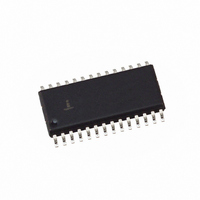HI5741BIB Intersil, HI5741BIB Datasheet - Page 9

HI5741BIB
Manufacturer Part Number
HI5741BIB
Description
IC DAC 14-BIT 100MSPS 28-SOIC
Manufacturer
Intersil
Datasheet
1.HI5741BIB.pdf
(13 pages)
Specifications of HI5741BIB
Settling Time
20ns
Number Of Bits
14
Data Interface
Parallel
Number Of Converters
1
Voltage Supply Source
Analog and Digital, Dual ±
Power Dissipation (max)
650mW
Operating Temperature
-40°C ~ 85°C
Mounting Type
Surface Mount
Package / Case
28-SOIC (7.5mm Width)
Lead Free Status / RoHS Status
Contains lead / RoHS non-compliant
Available stocks
Company
Part Number
Manufacturer
Quantity
Price
Company:
Part Number:
HI5741BIB
Manufacturer:
HARRIS
Quantity:
91
Part Number:
HI5741BIB
Manufacturer:
INTERSIL
Quantity:
20 000
Company:
Part Number:
HI5741BIBZ
Manufacturer:
Intersil
Quantity:
126
Detailed Description
The HI5741 is a 14-bit, current out D/A converter. The DAC
can convert at 100 MSPS and runs on +5V and -5.2V
supplies. The architecture is an R/2R and segmented
switching current cell arrangement to reduce glitch. Laser
trimming is employed to tune linearity to true 14-bit levels.
The HI5741 achieves its low power and high speed
performance from an advanced BiCMOS process. The
HI5741 consumes 650mW (typical) and has an improved
hold time of only 0.25ns (typical). The HI5741 is an excellent
converter for use in communications applications and high
performance video systems.
Digital Inputs
The HI5741 is a TTL/CMOS compatible D/A. Data is latched
by a Master register. Once latched, data inputs D0 (LSB)
through D13 (MSB) are internally translated from TTL to ECL.
The internal latch and switching current source controls are
implemented in ECL technology to maintain high switching
speeds and low noise characteristics.
Decoder/Driver
The architecture employs a split R/2R ladder and segmented
current source arrangement. Bits D0 (LSB) through D9 directly
drive a typical R/2R network to create the binary weighted
current sources. Bits D10 through D13 (MSB) pass through a
“thermometer” decoder that converts the incoming data into 15
individual segmented current source enables. This split
architecture helps to improve glitch, thus resulting in a
more constant glitch characteristic across the entire output
transfer function.
Clocks and Termination
The internal 14-bit register is updated on the rising edge of the
clock. Since the HI5741 clock rate can run to 100 MSPS, to
minimize reflections and clock noise into the part, proper
termination should be used. In PCB layout clock runs should
be kept short and have a minimum of loads. To guarantee
consistent results from board to board, controlled impedance
PCBs should be used with a characteristic line impedance Z
of 50Ω.
To terminate the clock line, a shunt terminator to ground is
the most effective type at a 100 MSPS clock rate. A typical
value for termination can be determined by the equation:
for the termination resistor. For a controlled impedance board
with a Z
used at the receiving end of the transmission line or as close
to the HI5741 CLK pin as possible.
R
T
=
Z
O
O
of 50Ω, the R
T
= 50Ω. Shunt termination is best
9
O
HI5741
Rise and Fall times and propagation delay of the line will be
affected by the shunt terminator. The terminator should be
connected to DGND.
Noise Reduction
To reduce power supply noise, separate analog and digital
power supplies should be used with 0.1µF and 0.01µF
ceramic capacitors placed as close to the body of the
HI5741 as possible on the analog (AV
supplies. The analog and digital ground returns should be
connected together back at the device to ensure proper
operation on power up. The V
decoupled with a 0.1µF capacitor.
Reduction of digital noise (caused by high slew rates on the bit
inputs to the HI5741) can be accomplished through the use of
series termination resistors. The use of serial resistors, which
combine with the input capacitance of the HI5741 to induce a
low pass filter characteristic, keeps the noise generated by high
slew rate digital signals from corrupting the high accuracy
analog data. Refer to Application Note AN9619 “Optimizing
setup conditions for high accuracy measurements of the
HI5741” for further details on selecting the proper value of
series termination to meet application specific needs.
Reference
The internal reference of the HI5741 is a -1.23V (typical)
bandgap voltage reference with 50µV/°C of temperature drift
(typical). The internal reference is connected to the Control
Amplifier which in turn drives the segmented current cells.
Reference Out (REF OUT) is internally connected to the
Control Amplifier. The Control Amplifier Output (CTRL OUT)
should be used to drive the Control Amplifier Input (CTRL IN)
and a 0.1µF capacitor to analog V
time by providing an AC ground at the current source base
node. The Full Scale Output Current is controlled by the REF
OUT pin and the set resistor (R
I
The internal reference (REF OUT) can be overdriven with a
more precise external reference to provide better
performance over temperature. Figure 21 illustrates a typical
external reference configuration.
OUT
FIGURE 21. EXTERNAL REFERENCE CONFIGURATION
(Full Scale) = (V
FIGURE 20. HI5741 CLOCK LINE TERMINATION
(26) REF OUT
HI5741
Z
O
REF OUT
= 50Ω
CC
SET
/R
R
EE
power pin should also be
SET
T
). The ratio is:
= 50Ω
. This improves settling
-5.2V
CLK
) x 16.
EE
-1.25V
R
) and digital (DV
HI5741
DAC
September 20, 2006
FN4071.12
EE
)













